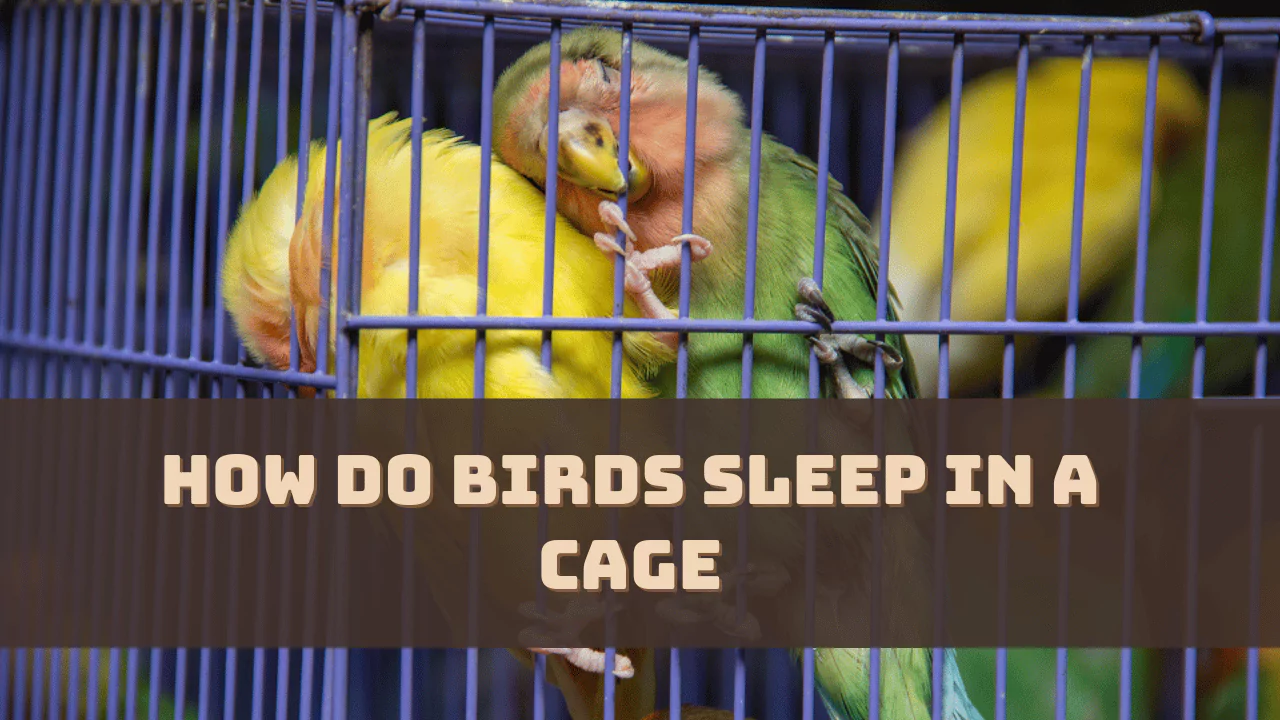Birds living in the wild are spotted sleeping perched on a branch or rod with their heads turned towards the back. This position helps to reduce the surface area, helping to tackle the cold air currents and also conserve energy.
However, the pet birds who sleep in the cage are seen to perch on the swing or rope present inside the enclosure. They are also seen resting on the bedding material provided inside the cage, which can be either shredded paper or wood chips.
So, let’s get to know how you can create an ideal environment for the pet birds to sleep and stay healthy.
How Birds Sleep While Perching?
Birds can naturally perch on poles or tree branches, and they like to sleep while perching. Their feet have tendons that are developed to grip anything strongly, it acts as a lock system so the birds can stay balanced, without falling, even when they are sleeping. Thus, it is always advised to install perches within the cage, and it should be of appropriate size based on the species of bird you are keeping as a pet. They are also seen to sleep with one eye open to protect themselves from danger or predators.
How to Design the Cage so that Bird Can Sleep Comfortably?
You must not ignore the importance of consistent sleep for the bird’s well-being, which also includes a well-balanced sleeping pattern.
- Install perches inside the cage which should be wide enough so that the bird’s toes do not overlap and while they are standing, the feet should not touch each other.
- You can provide the birds with options by installing multiple perches at different heights. Consider the fact that foot problems can be generated when they are trying to grip onto the same type of surface for a long time, so try to bring variation.
- You need to build them a safe and secure environment, where they can rest peacefully, so cover the cage at night.
- While the bird is sleeping there should not be any loud noises or sudden disruption, otherwise it might threaten the bird.
- You must also maintain a regular bedtime routine for the birds and before they go to bed, ensure that the cage is clean.
How to Choose the Ideal Bedding for a Bird?
When it comes to providing bedding to birds you must consider cushioning, insulation, moisture absorbing tendency, and removing odor capacity. You must also consider dust level, ease of cleaning facility, and cost. There are 4 popular choices, such as newspapers, corn cob, pine shaving, and paper pellets.
Do remember that newspapers can be an easy choice but high levels of duct can accumulate in it creating respiratory issues for the bird. While choosing pine shavings consider the signs of toxicity and if you choose corn cob, then replace them frequently, otherwise molds can develop. On the other hand, if budget is not an issue for you, then go for paper pellets.
How to Ensure that the Bird Gets Good Sleep?
If you want your pet bird to get good sleep, then understand their sleep cycles. A bird takes 12 hours of nap initially but this goes through short naps throughout the day. They can doze off, even if they are standing on one foot. To help them get a good night’s rest –
Choice of Space
Create an environment that promotes sleep and has enough space so that they can stretch their wings comfortably. Create a dark sleeping area for the birds to sleep so that the birds can get enough sleep which is required for their mental and physical well-being. This would also make them feel safe, secure, and cozy.
Cover the Cage
Cover the cage with breathable fabric such as cotton or linen which would block out the light. Also, turn down the noise level of either the television or any music system during the bedtime hours of the bird.
Choose the Surrounding Activities
Do not place the cage in the high activity area of the house and there should be enough ventilation, along with a temperature control system for the bird’s cage. To improve the air quality of the room where the cage is placed, use fans or air purifiers, otherwise stagnant air can lead to respiratory diseases in birds. Based on the season and climatic conditions, you can switch between either heating lamps or cooling fans.
Note the Sleeping Pattern
Keep a note of the sleeping pattern of the bird. If you find the feathered friend to sleep more than usual or seem to be excessively tired or unable to fall asleep, then immediately contact a veterinarian, as these can be signs of underlying disease.
Do Birds Sleep with One Eye Open?
Yes, birds sleep with one eye open, and this is their unique ability that helps them to stay vigilant even while resting. They have a special nictitating membrane covering the eyes, but it allows them to see. It acts as an invisible shield, where they can keep an eye on the threat without compromising their vision.
How Birds Cope with Noisy Environment?
Birds are light sleepers and get easily disturbed by the noise around them, while they are sleeping. So, to cope with this disturbance, they adjust their sleep pattern and take shorter naps throughout the day.
Do Birds Dream?
It is difficult to give a confirmed answer, but studies suggest that at different stages of sleep, birds might experience dreams. Birds have been observed to exhibit similar behavior as human REM (Rapid eye movement), which is considered to be the dreaming stage during sleep. Birds are also seen twitching or vocalizing while sleeping but there is no indication that they are actually dreaming or it is a physiological response.




